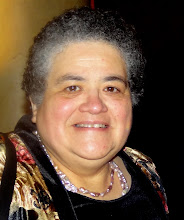Woman making mud cookies
The scenes of horror coming in from Haiti beggar the imagination. Haiti, on an ordinary day, is so inconceivably poor that we hardly have the language to describe it. We hear now that 80% of Port-au-Prince lies in rubble; that thousands of bodies are being scooped up by bulldozers and dumped into mass graves; that the infrastructure has collapsed so completely that rescue organizations cannot safely distribute the water and food to keep the survivors alone; even the scenes of war we see coming from Afghanistan and Iraq hardly match Haiti.
Some time back, long before the earthquake, I read a story so horrifying from Haiti that I set about to make a slide show for my classes: In Haiti, people are so poor that women make mud cookies. They mix earth, water and salt; make them into cookies, and bake them in the sun. Then they sell them to others who have nothing else to eat. To one accustomed to hearing about the epidemic of obesity in this country, especially among the poor, eating mud cookies is beyond the realm of my imagination. I keep looking at those pictures because my brain just can’t take them in. I have visited some very poor areas in Latin America but imagining human beings eating mud cookies is more than I can manage.

It is heartening to see Americans mobilize to respond to the disaster in Haiti. Television and radio programs, as well as Internet sites are being the drums for contributing whatever we can. As a colleague of mine said, “I just want to go to the bank and put it all in a pile and say, ‘Here; take it all.’”
One poll I saw said that 37 % of Americans had contributed to help the Haitians though it may be that the total amount of charity we give ordinarily is quite generous. In 2005, in the wake of the Asian tsunami, the U.S. government pledged $900 million tsunami relief. Individual Americans donated over $2 billion; more than twice what was provided by the government.
The following year, 2006, the total given by individual Americans to charity topped $295.3 billion; 38% of that went to religious organizations. About 65% of that came from households earning less than $100,000. Americans are so generous that we give 1.85% of our Gross Domestic Product (GDP) to charity; Israel, the next country on the list, gives 1.34% , and Canada, 1.7% of its GDP to charity. Mega-givers, such as financier Warren Buffet promised $30 billion to the Bill and Melinda Gates Foundation, to be distributed over a period of 20 years.
None of this takes into account the number of Americans who give their time as well as their dollars to charity. Swedes outrank all others in volunteerism; Norway is second, and the United States is third.
But to return to the disaster in the Caribbean, Haiti will be in a state of emergency for so long as it takes for the worst to pass: for everyone to be fed and sheltered; for all of the bodies to be buried. Once the immediate emergency passes, we will have to find a way to rebuild Haiti and get it on its feet. I hope that we can think in terms of the post-World War II schema to rebuild Europe and Japan. Indeed, the pictures of the piles of rubble in Haiti bring to mind similar pictures from Germany and Britain after the war or Hiroshima after the bomb.
I wonder, though, if Haiti has the internal resources to become truly autonomous. Haiti has had a long, sad history of subsistence existence spawned by colonial abuse by the Spanish and French and political manipulations by the United States. There is no lack of willingness of the U.S. and other powerful countries in the world to help out in a crisis but what Haiti needs in the long run is a chance to stand on its own two feet. The old adage: ‘Give a man a fish, and he’ll eat for a day; teach a man to fish and he’ll eat for a lifetime,’ is one that should govern our efforts. More than that, the United States has to let go; get Haiti on its feet, and then let go. That may seem like a very far goal but one that we must keep. Let us work to make the earthquake a mixed blessing: So awful that the whole world joins to pick Haiti up and help make it truly independent.

Woman tasting mud cookie before buying
photos by Ariana Cubillos/ AP Photo



.jpg)

